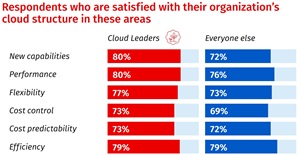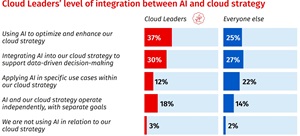News
What Makes a 'Cloud Leader?'
The new "2025 State of the Cloud" report from multicloud specialist Rackspace defines a "cloud leader."
So what characteristics make up a cloud leader, or a company or organization at which IT decision-makers have integrated cloud fully into their business strategy and are using their cloud strategy to support their organizational objectives?
The new report from Rackspace, updated last week, explains the concept, stemming from respondents' answers to a big survey.
"Among our 1,400+ respondents, 16% have an advanced level of cloud adoption," the report said. "They describe cloud as fully integrated into their organizational strategy, and aligned with wider business objectives. We call these thriving respondents 'cloud leaders,' and there are interesting differences between many of their responses and those of other IT decision-makers."
Example data points include:
- Cloud leaders are more likely to use a particular cloud platform because it's well aligned with their overarching cloud strategy (42%, compared to 33% of other decision-makers)
- They are leading other IT decision-makers when it comes to integrating AI, with 37% using AI-driven cloud optimization to refine their cloud strategy, compared to 25% of others
- Most cloud leaders prefer a comprehensive workload-by-workload analysis to decide where to host all of their workloads (54%), compared to 38% of other decision-makers, who are more likely to only analyze where to put critical workloads
"These are our 'cloud leaders,' and they are thriving," the report said. "When we compare their performance to businesses with less strategic and integrated cloud technology, the advantages are clear. By properly integrating cloud into their business strategy, cloud leaders are seeing improved performance across the board, but particularly in their cloud strategy's flexibility, performance, new capabilities and cost control."
Here's more data on cloud leaders pulled from the report.
Respondents Who Are Satisfied with Their Organization's Cloud Structure in These Areas
 [Click on image for larger view.] Respondents Who Are Satisfied with Their Organization's Cloud Structure in These Areas (source: Rackspace).
[Click on image for larger view.] Respondents Who Are Satisfied with Their Organization's Cloud Structure in These Areas (source: Rackspace).
"Regardless of the solutions they adopt to meet their business needs, organizations are primarily driven by the need to enhance flexibility, reliability and availability while controlling costs," the report said. "These factors are the top reasons that organizations give for being drawn to their primary cloud strategy, whether they prioritize hybrid, multicloud, public or private cloud solutions.
"But cloud leaders are also planning their cloud strategy and which platforms they use differently -- and for different reasons -- from other IT decision-makers. Each organization has unique needs and capabilities influenced by factors such as industry, location and existing IT infrastructure, which can mean these same key drivers can lead organizations to choose different solutions.
"However there are key criteria that thriving organizations are always focusing on. Resource utilization, flexibility and security are critical areas for success, and they are consistent priorities for cloud leaders irrespective of whether they mostly use hybrid, public, private or multicloud as the best solution for their circumstances. When it comes to resource utilization, cloud leaders are highly focused on optimizing their resources to achieve better performances and drive efficiency.
"Cloud leaders are much more likely to be using a particular platform because it is well aligned with their overarching cloud strategy, with 42% saying one of their main reasons for using their primary solution is because it aligns with their cloud strategy, compared to 33% when it comes to everyone else. Multicloud is a strong solution when an organization needs a cloud strategy that prioritizes flexibility and the need to change in order to meet evolving business needs. Cloud leaders are significantly more likely to use multicloud to increase flexibility than other decision-makers, with 73% saying this is one of their main reasons for using this environment, and 50% saying the same for its ability to help them meet evolving business needs. Other types of cloud environments have different strengths, with cloud leaders more likely than other respondents to opt for hybrid to optimize performance and minimize latency, private for improved reliability, and public to align with their cloud .
Primary Reasons Cloud Leaders Choose Their Primary Cloud Environment
 [Click on image for larger view.]Primary Reasons Cloud Leaders Choose Their Primary Cloud Environment (source: Rackspace).
[Click on image for larger view.]Primary Reasons Cloud Leaders Choose Their Primary Cloud Environment (source: Rackspace).
Primary Reasons Cloud Leaders Choose Their Primary Cloud Environment (by type)
 [Click on image for larger view.]Primary Reasons Cloud Leaders Choose Their Primary Cloud Environment (by type) (source: Rackspace).
[Click on image for larger view.]Primary Reasons Cloud Leaders Choose Their Primary Cloud Environment (by type) (source: Rackspace).
Cloud Leaders' Level of Integration Between AI and Cloud Strategy
 [Click on image for larger view.]Cloud Leaders' Level of Integration Between AI and Cloud Strategy (source: Rackspace).
[Click on image for larger view.]Cloud Leaders' Level of Integration Between AI and Cloud Strategy (source: Rackspace).
"Integrating AI into the cloud is another area where cloud leaders are ahead of the curve," the report said. "Their cloud solutions are likely to be performing well in part because they are using AI to support their strategic planning: 37% use AI-driven cloud optimization to refine their strategy, compared to 25% of other decision-makers."
Other data related to cloud leaders include:
- Cloud leaders are particularly championing diverse cloud strategies across multiple providers, with 24% intending to explore multiple cloud providers to develop their strategy compared to just 9% of everyone else.
- Almost all decision-makers use some form of process when deciding where to host workloads, but cloud leaders are using one solution in particular to help them create a thriving tech architecture. 54% have implemented a comprehensive workload-by-workload analysis system, as compared to 38% of other decision-makers, who are much more likely to only conduct this level of detailed analysis for critical workloads.
- Leaders commonly cite scalability, enhanced performance and security and increased operational efficiencies as reasons that their organization's cloud environment is exceeding expectations. For those whose solutions are not performing as expected, they are typically facing cost overruns, cloud integration issues, and, in many cases, a talent gap accompanied by limited internal expertise.
- Cloud leaders are particularly likely to be making use of AI's capabilities for advanced threat detection, with over half utilizing it for this (52%), compared to 40% of other respondents.
"As organizations continue to advance their cloud infrastructure and leverage more complex environments such as hybrid and multicloud, the demand for skilled professionals is outstripping the supply,” said Ben Blanquera, VP of Technology and Sustainability at Rackspace, in a news release. "Enterprises must prioritize upskilling their teams to effectively leverage the advanced tools essential for modern IT management. In addition, they can partner with cloud experts like Rackspace. Based on the survey findings, as well as insights from our customers and partners, it's clear that there is strong, continued demand in the market for professionals with expertise in key areas such as Kubernetes, serverless architectures, and cloud security."
The report was conducted by Coleman Parkes Research in October and November 2024. Findings are based on the responses of 1,420 IT decision-makers across manufacturing/logistics, retail, hospitality/travel, energy, healthcare/pharma/biomedical, government, media/entertainment, and financial service sectors in the Americas, Europe, Asia, and the Middle East. Most companies/organizations polled have from 1,000 to 10,000-plus employees and annual revenue between $50 million and $15 billion.
About the Author
David Ramel is an editor and writer at Converge 360.